

The Cambridge University Real Tennis Club is located on Grange Road, Cambridge, England. [1] The club runs under the auspices of the University of Cambridge. It is one of the few real tennis clubs and courts in the United Kingdom.


The Cambridge University Real Tennis Club is located on Grange Road, Cambridge, England. [1] The club runs under the auspices of the University of Cambridge. It is one of the few real tennis clubs and courts in the United Kingdom.
In 1866, a real tennis court was built at the western end of Burrell's Walk, close to Grange Road, on land leased from Clare College. [2] Funding was raised by private subscription from several fellows of Clare and Trinity College, for the use of senior and junior members at these colleges. In 1877, use of the court was extended to King's College. A second court was erected at the same site in 1890, converted into four squash courts in 1933, but reopened for real tennis in 1999. [3] In 1902, use of the facilities was extended to any member of Cambridge University.
In 1958, associate membership was introduced for real tennis players who were not members of the university. The name of the court changed from Clare and Trinity Tennis Courts to Cambridge Tennis and Squash Rackets Courts. The courts were managed by a committee. After World War II, the Cambridge University Tennis Club was formed. By around 1959, it had become known as the Real Tennis Club.
In 1974, the freehold of the site was acquired from Clare College by the university. The building was listed at grade II in 2014. [4]

Trinity College is a constituent college of the University of Cambridge. Founded in 1546 by King Henry VIII, Trinity is one of the largest Cambridge colleges, with the largest financial endowment of any Oxbridge college. It is the largest Oxbridge college measured by the number of undergraduates (730). Trinity performs exceptionally as measured by the Tompkins Table, coming top from 2011 to 2017, and regaining the position in 2024. Trinity was the top-performing college for the 2020–21 undergraduate exams, obtaining the highest percentage of good honours.
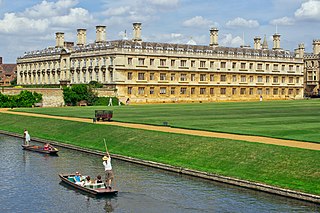
Clare College is a constituent college of the University of Cambridge in Cambridge, England. The college was founded in 1326 as University Hall, making it the second-oldest surviving college of the University after Peterhouse. It was refounded in 1338 as Clare Hall by an endowment from Elizabeth de Clare, and took on its current name in 1856. Clare is famous for its chapel choir and for its gardens on the Backs. It is a registered charity.

Selwyn College, Cambridge is a constituent college of the University of Cambridge. The college was founded in 1882 by the Selwyn Memorial Committee in memory of George Augustus Selwyn (1809–1878), the first Bishop of New Zealand (1841–1868), and subsequently Bishop of Lichfield (1868–1878). Its main buildings consist of three courts built of stone and brick. There are several secondary buildings, including adjacent townhouses and lodges serving as student hostels on Grange Road, West Road and Sidgwick Avenue. The college has some 60 fellows and 110 non-academic staff.

Hughes Hall is a constituent college of the University of Cambridge in England. It is the oldest of the University of Cambridge's postgraduate colleges. The college also admits undergraduates, though undergraduates admitted by the college must be aged 21 or over. There is no age requirement for postgraduate students. The majority of Hughes Hall students are postgraduate, although nearly one-fifth of the student population comprises individuals aged 21 and above who are studying undergraduate degree courses at the university.

Queens' College is a constituent college of the University of Cambridge. Queens' is one of the 16 "old colleges" of the university, founded in 1448 by Margaret of Anjou. Its buildings span the River Cam with the Mathematical Bridge and Silver Street connecting the two sides.

Clare Hall is a constituent college of the University of Cambridge. Founded in 1966 by Clare College, Clare Hall is a college for advanced study, admitting only postgraduate students alongside postdoctoral researchers and fellows. It was established to serve as an Institute of Advanced Studies and has slowly grown and developed into a full constituent college. It is a registered charity.

Since 1961 Leckhampton has been the residential site for postgraduate students of Corpus Christi College of the University of Cambridge, England. It consists of the late-19th-century Leckhampton House, the George Thomson Building, dating from 1964, and several other nearby houses. In 2012, a new, purpose-built accommodation building was built to house additional students. The new building was opened on 14 September 2012 by the College Visitor and Chancellor of the University, David Sainsbury.
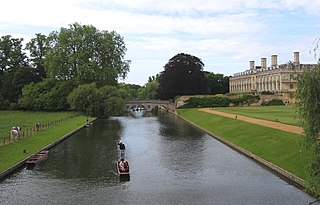
The Backs is a picturesque area to the east of Queen's Road in the city of Cambridge, England, where several colleges of the University of Cambridge back on to the River Cam with their grounds covering both banks of the river.
Cambridge University Lawn Tennis Club was founded in 1881, seven years before the Lawn Tennis Association of Great Britain was founded. Although it is called a 'club', it is actually the lawn tennis association of the whole of the University of Cambridge, representing the university as a whole, the thirty-one colleges, and other institutions which are part of the university.
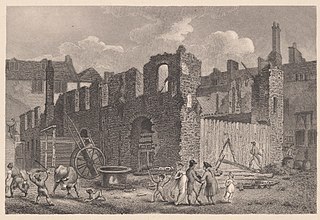
Gibbon's Tennis Court was a building off Vere Street and Clare Market, near Lincoln's Inn Fields in London, England. Originally built as a real tennis court, it was used as a playhouse from 1660 to 1663, shortly after the English Restoration. As a theatre, it has been variously called the "Theatre Royal, Vere Street", the "Vere Street Theatre", or simply "The Theatre". It was the first permanent home for Thomas Killigrew's King's Company and was the stage for some of the earliest appearances by professional actresses.

Burrell's Field provides student accommodation as part of Trinity College, Cambridge, England. It is located between Queen's Road and Grange Road. It comprises three parts:
William Cecil Marshall was a British architect and amateur tennis player, who was runner-up in the very first Wimbledon tournament to Spencer Gore in 1877. Marshall designed private houses and university buildings in Cambridge, a university building in Dublin, and tennis courts in Cambridge and London, and extended Down House for his friend Charles Darwin. He was an original member of the Art Workers' Guild.
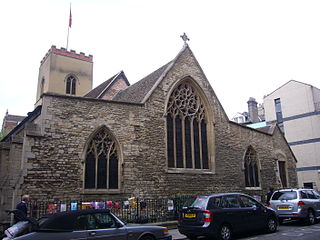
St Edward King and Martyr is a church located on Peas Hill in central Cambridge, England. It is dedicated to Edward the Martyr, who was King of England from 975 until his murder in 978. In 1525 it was at St Edward's that what is said to have been perhaps the first "openly evangelical" sermon of the English Reformation was delivered, and the church is sometimes labelled the "Cradle of the Reformation".
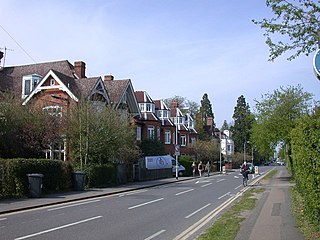
Grange Road is a street in Cambridge, England. It stretches north–south, meeting Madingley Road (A1303) at a T-junction to the north and Barton Road (A603) to the south. It runs approximately parallel with the River Cam to the east. Grange Road is almost one mile long and has 17th-century origins. It contains several colleges of the University of Cambridge.
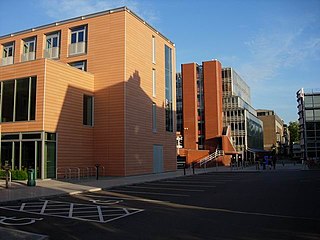
West Road is located in western Cambridge, England. It links Grange Road to the west with Queen's Road to the east. The road is north of Sidgwick Avenue and the Sidgwick Site, a major site of the University of Cambridge, currently under redevelopment. Facilities on West Road include the Cambridge University Faculty of Law, the Faculty of Music, the Faculty of English and the Department of Anglo-Saxon, Norse and Celtic, and the West Road Concert Hall.

Sidgwick Avenue is a road located in western Cambridge, England. The avenue runs east-west and links Grange Road to the west with Queen's Road to the east. The line of the road continues northeast into central Cambridge as Silver Street. Sidgwick Avenue is flanked by Newnham College, Ridley Hall, Selwyn College and the Sidgwick Site of the University of Cambridge.

The Old Schools are part of the University of Cambridge, in the centre of Cambridge, England. The Old Schools house the Cambridge University Offices, which form the main administration for the University.
David Wyn Roberts was a British architect and educator, who designed more university buildings for Cambridge University than any other architect. With a modernist practice based in Cambridge, he also designed many city housing projects, schools, and private residences.

Wilberforce Road is a street in the western outskirts of Cambridge, England, which runs north–south for 550 metres, connecting Madingley Road with Adams Road, which runs eastwards to Grange Road. The road was built in 1933, although several of its buildings date from earlier in the 20th century. It was named after William Wilberforce, the anti-slavery campaigner. Wilberforce Road falls within the conservation area of West Cambridge. As of 2022, the usage is a mix of private housing and buildings and sports facilities associated with the university and colleges, including the Centre for Mathematical Sciences. There are two listed buildings, Emmanuel College's sports pavilion (1910) and the Modernist-style number 9 (1936–37).

There are 833 listed buildings in the district of Cambridge, England. This list summarises the 87 in the west and north-west suburbs, in the area west of the Backs and broadly between Huntingdon Road, Queen's Road, Barton Road and the M11. This was the West Fields, which largely passed into the ownership of the Cambridge colleges, particularly St John's, after enclosure in 1805, and was little developed until after 1870; the older population centres of Castle Hill and Newnham are excluded from this list. The major roads are Madingley Road running east–west and Grange Road running north–south. There are 18 buildings listed at grade II*, with the remainder at grade II; there are no grade-I-listed buildings in this area.
52°12′19″N0°06′23″E / 52.2053°N 0.1063°E